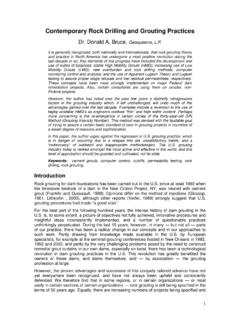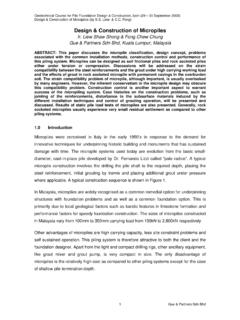Transcription of When do ratings implicate perception versus …
1 When do ratings implicate perception versusjudgment? The overgeneralization test for top-down effectsChaz Firestone and Brian J. SchollDepartment of Psychology, Yale University, New Haven, CT, USAABSTRACTWhen looking at an object say, a banana we can both directlyperceiveitsvisual qualities ( , its size) and also make higher-leveljudgmentsabout itsvisual and non-visual properties ( , not only its size, but also its cost).Suppose you obtain a rating of a property such as size. Does that ratingimplicate seeing or merely higher-level judgment? The answer often matters agreat deal , determining whether such ratings imply top-down effectsof cognition on perception . Too often, however, this distinction is ignored inempirical investigations of such effects. Here we suggest a simple test forwhen such ratings can be used to implicate perception : whenever the verysame experiment overgeneralizes to an unambiguouslynon-perceptualfactor, the results cannot be used to draw implications about perception , perse.
2 As a case study, we investigate an empirical report alleging thatconservatives perceive Barack Obama as darker skinned than liberals do. Twosimple experiments show that the very same effects, measured via the same representativeness ratings , obtain with unambiguously non-perceptual andeven silly factors (involving bright red horns vs. halos, rather than brightnessdifferences). We suggest that this renders such methods unable to implicatevisual processing and we recommend that overgeneralization tests of thistype always be conducted in such HISTORYR eceived 20 October 2015; Accepted 16 February 2016 KEYWORDSTop-down effects; cognitive penetrability; lightness perception ; racial categorizationA foundational distinction in psychology is that between perception and cogni-tion and in particular, between directlyseeingsomething vs.
3 Merelyjudgingthat something is the case. For example, whereas we can directly see visualproperties such as the color or size of a banana, we can only infer, conclude,or judge that the banana is expensive or is grown in South , the same properties can often be directly seenandindirectly 2016 Informa UK Limited, trading as Taylor & Francis GroupCONTACTChaz of Psychology, Yale University,Box 208205, New Haven, CT 06520 8205, USAVISUAL COGNITION, 2015 VOL. 23, NOS. 9 10, 1217 1226 by [Yale School of Medicine] at 01:40 28 June 2016 judged: we can both see that an object is yellow and also conclude that anobject is yellow even without directly seeing it that way for example, if thelighting is poor but the object clearly has a banana s distinctive , one can often experience the distinction between perceiving andjudging for oneself, especially when the two processes conflict.
4 For example,when viewing a visual illusion, one oftenseesthe world in a way oneknowsitnot to be for example when looking at an impossiblefigure ( , a 3 DPenrose triangle), or when scrutinizing two objects that appear to be differentsizes even when a ruler gives the same measurement for each ( , the Ebbin-ghaus illusion). Similarly, in a more everyday context, drivers who learn thatobjects in convex passenger-side mirrors are closer than they appear mayoftenseean object as being at one distance and yetjudgethe object to beat a different vs. judgment in top-down effectsIntuitively, a great many provocative and potentially groundbreakingfindingsare much more groundbreaking if they reflect perception per se rather thanpost-perceptual judgment. For example, the possibility that perception isaffected by top-down factors such as our beliefs, desires, intentions,emotions, and other higher-level states is potentially revolutionary (for a criti-cal review see Firestone & Scholl,in press) but only if such states alterwhatwe see, and not if they simply change the judgments we make on the basis ofwhat we see (in which case they may not interact with foundational questionsin perception research, though they may of course be interesting for otherreasons).
5 For example, it would be truly groundbreaking to discover that lin-guistic labels literally alter an object s perceived color (as has been reported byMitterer, Horschig, M sseler, & Majid,2009), but it would be far more routine ifit turned out that peopleseethe same colors but simply call them by differentnames in different linguistic theoretical discussions of such top-down effects often acknowl-edge the importance of distinguishing perception from judgment ( , Balce-tis, in press; Collins & Olson,2014; Philbeck & Witt,2015), a surprising numberof empirical investigations seem to ignore this distinction altogether, both indiscussion and in terms of the actual experiments run (for a notable exception,see Witt, Proffitt, & Epstein,2010). This is particularly true for experiments thatrely on subjective ratings and other explicit, deliberate, unspeeded responses,which seem especially easily contaminated by post-perceptual case study: partisanship and Barack Obama s skin colorConsider a concrete case study of both theoretical and practical importance.
6 Ithas been reported that partisan attitudes can alter a politician s perceived skin1218C. FIRESTONE AND B. J. SCHOLLD ownloaded by [Yale School of Medicine] at 01:40 28 June 2016 color, such that Republicans and conservatives perceive Barack Obama ashaving darker skin than do Democrats and liberals (Caruso, Mead, & Balcetis,2009). The data used to fuel this conclusion were ratings of how well certainphotographs represented the politicians they depicted: when subjects wereshown multiple photographs of Obama, some having been lightened andsome darkened, conservative subjects were more likely than liberal subjectsto rate a darkened photo of Obama as more representative of him, ostensi-bly because they thought the photograph looked more like the such an effect reflect a literal perceptual distortion, such that Obama sskin trulylooksdarker to conservatives?
7 Or is it instead that conservative subjectssimply makejudgmentsconsistent with darker skin, while actual percepts may beunchanged? The original paper sometimesinterpretedtheseratingsaseviden ceof an effect on skin tone representations (Caruso et al.,2009, )withoutimplying an effect on visual perception per se; but at other times they suggestedthat the effect was on lightness perception (p. 20169) and framed their resultsin the context of unambiguous discussions of true visual perception (such as Bal-cetis & Dunning,2010;Bruner&Goodman,1947;Levin&B anaji,2006). In anycase, many other researchers have taken this result to unambiguously reflectchanges in visual processing. For example,adetailedfollow-upstudyinterpret edthe results as showing that top-down processing influences color perception (Kemmelmeier & Chavez,2014, ),andotherdiscussionsdescribetheresults as demonstrating that political affiliation can affect color perception (Branigan et al.)
8 ,2013, )andthatpartisanshipaffectsnotonly oursocial judgments of others but also our visual perception of their physical fea-tures (Broudy,2009, ).The overgeneralization testRegardless of how this result has been cited and discussed, the experimentsthemselves simply do not distinguish between perceptual and judgmentalinterpretations. (This is not an indictment of the original Caruso et al.,2009,work, however; it is not clear that their project ever intended to explore thisdistinction, and in fact some of their conclusions may follow just as readilyfrom a higher-level judgmental interpretation.) Because this distinctionreallymatters, though insofar as a perceptual interpretation has bold andeven revolutionary consequences for the nature of visual processing weare interested in whether rating data of this sort can fuel such many phenomena in vision science, top-down effects of cognitionon perception such as those discussed above are almost never possible to see for yourself (Firestone & Scholl,2015).
9 As a result, the only data to goon in the case of Obama s perceived skin color are the ratings themselves,VISUAL COGNITION1219 Downloaded by [Yale School of Medicine] at 01:40 28 June 2016 since there is no associated demo to experience. Here, we ask whether suchratings implicate perception , and we propose a simple test to help determinethe answer: if the same measures produce the same pattern of results with anunambiguouslynon-perceptual factor, then the method cannot be used todraw implications about example, suppose that, instead of rating the representativeness of arti-ficially lightened or darkened photographs, subjects instead saw photographsof Obama in which bright red horns or a yellow halo had been drawn on hishead, and they ratedthoseimages for representativeness . If the effectover-generalizes, such that the same pattern of results obtains even with this clearlynon-perceptual case (with conservatives rating the Obama-with-horns imageas more representative than the Obama-with-halo image), then the measure fails the test since, presumably, conservatives don t literally see Obama ashaving bright red horns on his head.
10 However, if the experiment does notproduce the same pattern of results with unambiguously non-perceptualfactors, then it may well be that the ratings reflect visual percepts per current experimentsHere we apply the overgeneralization test, exactly as described, to the case ofpartisan attitudes and perception of Barack Obama (Caruso et al.,2009). Wealtered images of Obama to have either bright red horns or a yellow haloon his head (Figure 1), and then we asked subjects to rate the representative-ness of these images. We subsequently collected information about subjects political attitudes, including whether they identified as Republicans or Demo-crats, to see whether political attitudes predicted which image was rated asmore 1: horns and halosMethodParticipantsA total of 221 subjects were recruited online through Amazon Mechanical-Turk.









